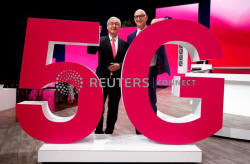|
"An
artificial shortage of public resources is being created, which
may push up the price," Hoettges told the company's annual
general meeting in Bonn, adding: "In the end, there is no money
for the build-out."
German regulators have carved out a slab of frequency suited for
use in high-tech 'connected' factories, and will allocate that
on a regional basis directly to industrial companies later this
year.
Four operators are, meanwhile, vying for a total of 420 MHz of
spectrum in the 2 GHz and 3.6 GHz bands in an auction that
started last week, with combined bids topping 1 billion euros
($1.1 billion) on Wednesday evening.
Industry analysts expect the amount raised at the open-ended
auction - in which Vodafone, Telefonica Deutschland and new
entrant 1&1 Drillisch are also taking part - to reach 3 billion
euros or more.
A court threw out challenges filed by the operators to halt the
auction. Litigation is still outstanding that could put the
auction's results to the test retroactively, the industry says.
Hoettges repeated earlier complaints about delays to winning
local approvals to erect new telecoms masts in Germany, which
can take two years or more, and urged the authorities to lighten
regulation to encourage investment.
He also called for more infrastructure sharing, in which
competitors can install antennas on the same towers, as a way to
ease the cost of building out 5G networks.
"We build the mast, and others can use it to mount their
antennas. Particularly in rural areas, where coverage gaps are
still large," he said.
(Reporting by Douglas Busvine; Editing by Mark Potter)
[© 2019 Thomson Reuters. All rights
reserved.] Copyright 2019 Reuters. All rights reserved. This material may not be published,
broadcast, rewritten or redistributed.
Thompson Reuters is solely responsible for this content.

|
|





